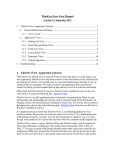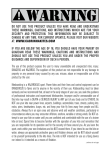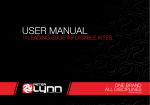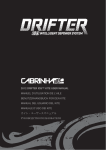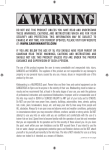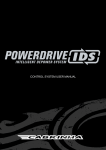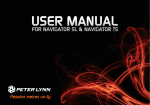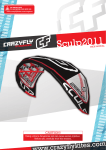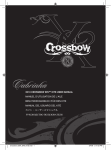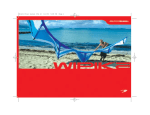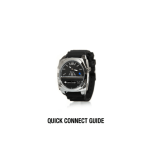Download Read more
Transcript
!WARNING! Please read the information of this booklet first and then only use the product if you agree on all the terms and conditions! We draw your attention to changes at any time without notice. If you are not yet 18 years old, there is at least one parent or legal guardian responsible for reading all the listed instructions of this user manual as well as taking care of those being understood. The use of the products involves many unavoidable and unexpected risks, injuries and dangers for the user. The distributors of these products are not responsible for damage to property or personal injury which arise from the use of the products or by negligent or irresponsible use by the user. Kiteboarding is an extreme sport. Tubekites including their lines and control system can be dangerous for flying devices and anyone who comes too close to them. Take kiteboarding and the risks involved seriously. When you start kiteboarding, get in any case help from experienced kiters or – better go directly to a qualified kite instructor or a kite school. Improper or negligent use of these kites can cause serious injuries or even death. Never use the kite near power lines, airports or roads and always keep the lines in a sufficient safety distance from people and obstructions. Only fly the kite where you have enough space available. Watch the wind and weather conditions and be cautious with off-shore, on-shore or extremely gusty winds. Only use the kite on the water when you are able to control the kite on the shore yourself. Keep in mind that you are always responsible for the handling and that safety always comes first. Assess your riding skills realistically and never kite, if you are not 100% sure that the conditions match your riding skills. Always wear appropriate safety equipment as well as a swimming aid, if you use the kite on the water. Never link yourself permanently to the kite. The kite is neither a flight device nor suitable as a flotation device. Recommendation for the use of your kiteboarding equipment: - Kiteboarding is a dangerous sport and kiting involves the risk that practicing this sport may cause serious injuries or even death. - Injuries pose a risk and practicing this kind of sport implies the acceptance of such risks. - If at all, children should practice this kind of sport only under adult supervision. - Kiteboard beginners should attend a kiting course at a certified school. - Always check your equipment before use on possible damage, especially the lines and bladders are susceptible. - If you notice any damage at the equipment, defective parts need to be replaced immediately before the equipment is used again. - Only use high-quality renewal parts from reputable suppliers. - Get yourself informed about the respective kite-spot in advance: Tides, currents and weather forecasts always need to be clarified ahead. Never kite at off-shore wind. - Be considerate to other riders or visitors on the kite-spot. You have the full responsibility of your material all the times. - Always wear suitable protective equipment. Depending on the weather conditions, a wet suit, sunglasses, UV top ... We recommend that you always wear an appropriate water sports helmet. - Never go on your own on the water and take several breaks. - If the conditions change, for example an upcoming thunderstorm, leave the water immediately. This also applies to extremely decreasing wind. - Assess your riding skills realistically and do not put too much strain on your body. - Do not make any modifications to our offered products. - Keep this user manual and read it again, if needed. Use on snow: - The kites are intended for the use on snow as towing equipment which lets the rider slide over snow fields. - Do not use the kite to sail from mountains, rocks or pistes. - Avoid a harsh landing in the snow because there could be hidden rocks or chunks of ice underneath. - Always remember that using the kite in the mountains is always combined with increased risks. For example, there can be fast-changing weather and wind conditions without noticing this before. - Never kite near trees, lifts or power lines. - Never tie yourself onto a snowmobile or any other objects. - People who are in lee or seen far down the piste from your perspective have the right of the way. You have the responsibility and must always keep enough distance. - Never stop behind hills or bends. You could obstruct others and pose an additional risk. - While you launch the kite always consider to pay attention to the others‘ right of the way and keep the area in luv in view. - Pay attention to signs and warnings. - Always keep sufficient distance to restricted areas. - Never kite, if you are under the influence of alcohol and/or drugs. Thank you for purchasing a F2 product and welcome to the world of kiteboarding! Kiteboarding is a great sport and has an enormous attraction to many people of all age levels. It is one of the most dynamic and fastest growing sports of this decade. IMPORTANT: In kiting, it is possible to dangerously lose control. So it is very important to us that you are introduced to this perhaps new sport – for you – with the necessary expertise and respect. This user manual will help you in practicing your sport for a long time and with much pleasure. Please read all the information given before using your new equipment. This reference booklet does certainly not replace any kiting lessons. Always keep in mind that it concerns your own safety and those around you. Important note: Kiteboarding is an extremely dangerous sport with a potential risk of injury. Please get familiar with the following safety instructions before you start: - Get yourself familiar with the safety system of your kite. - Check the correct setup and the correct attachment of the lines to the kite. - Always use the kite with a safety leash. - Never constantly tie the kite with the bar or the lines. - Never use the kite as a flying device. - Never touch the flying lines while these are under tension and do not try to catch the kite or even hold onto it. - Always secure your inflated kite with sand or another heavy object. - Only lend the kite to persons that you know personally and also that they can certainly handle it. - Check your equipment before you go on the water. Also check the correct setup of all components. We recommend as protective equipment: - helmet - life jacket - wet suit - gloves - sunglasses - sun lotion - safety knife, if not on the trapeze IMPORTANT INFORMATION Wind, water and weather conditions: - Do not underestimate the strength of the wind. - Make yourself aware that weather conditions are not always predictable and fast-changing. - Avoid kiting at on- and off-shore as well as gusty winds. - Be especially cautious outside the shallow-water area as well as in wave conditions. - Get yourself informed about currents and tides. - Assess your skills realistically and take several breaks throughout the day. - Get yourself informed about the water and air temperatures and protect yourself by wearing a wet suit. - Never go on the water during a thunderstorm or risk of one. - Determine the wind using an anemometer before you start to kite. - Do not choose a too large kite. In case of questionable conditions always take the smaller one. - Make sure that you are able to handle the safety system in case of emergency. Wind range: The wind range can unfortunately not be measured in the same way for all riders. The right kite size always depends on the rider weight, riding skills, water conditions and board size. Let yourself be guided by personal experiences when choosing the kite size and be oriented towards the sizes which other kiters use at their skill levels. Lighter riders always use smaller kite sizes than riders with a higher body weight. Assessment of your riding skills: - Never kite without having got an introduction in advance. - Never kite on your own. - Always launch and land with a partner and inform that a second person is watching for you. - Make sure in advance that you are in good physical condition. - Only kite, if you can swim safely. - Make sure that your riding skills match the wind and water conditions and that you have chosen the right material. - Only kite as far from the shore away as you could possibly swim back again. - Never kite to the point of complete physical exhaustion. - Do not ask any stranger for assistance at launching or landing, especially not when this person is not sure about the handling. - Always remember that you are responsible for safe handling yourself. Behavior at the kite-spot: - Respect local laws. - Always talk to local riders in advance, so that you can assess the local conditions. - Make sure you have enough space for launching and landing. You should have at least 100 meters of free space in lee and also to either side. - Avoid areas with reefs, rocks and shoals. - You can observe the change of water level and the risks involved, arising from this fact. - Stay away from swimming areas or crowded beaches. - Make sure your lines are not on footpaths or streets. - Show consideration for all others participating in water sports. - Make sure that there is another landing site, if you can not make it to your initial one. Handling the kite: - Carefully check your safety equipment to make sure it is functioning properly. - Regularly check your kite and the safety system, so you can spot small holes and cracks or worn areas at an early stage and fix them, if necessary. - Pay close attention to your lines because these could be heavily worn by small knots and even tear this way. - Never setup your kite on abrasive surfaces such as asphalt or gravel. The best bases are sand and grass. - Always secure the kite with sand or another heavy object that will not damage the kite. Storing of the kite: - Before packing up your kite, rinse it off with fresh water. - Before rolling up, dry the kite and clean it from sand and dirt. - Use the included storage bag and put the kite in a dry and cool place. - Do not put your board for storing on the kite. - Deflate the tubes when storing the kite in a roof carrier box. Due to the extreme temperatures, the bladders could be destroyed. - Always wash off the bar with fresh water and let it completely dry before storing it. Safety and general rules of behavior: - Follow the summarized safety instructions in this user manual. - Follow all instructions and rules that relate to a territory. - Get all the necessary information on a new territory before you go out there on the water. - Never touch someone else's material, unless the owner asks you to do so. - Never leave an inflated kite without supervision. If the wind suddenly changes its direction, the kite can take off. Setup of the kite: - Always just set up as much equipment as you can handle immediately. - Set up your equipment only at places with enough space so that others can also use this space. - Roll up your lines when you take a break. - Always take consideration for other people when you launch or land your kite. - Help other riders because they will gladly give it to you in return. Starting: - Always choose a safe launching place with enough space in lee (100 meters) and also to either side. - Position your kite so that it is clearly in the direction of beam reach. Never in downwind as the kite would then launch with too much power. Those who start this way threaten their own life and that of others. - Stand so that the wind is from behind on your back. This direction of the wind is referred to as 180 degrees. Position yourself to launch the kite downwind at about 100 degrees, either left or right. - The more you position your kite into the wind, the less power develops at launching. A safe launch is possible. - The kite is held by an experienced partner in the wind. Then you can start your kite slow and safe between half- and downwind. The wind window and its the different zones: Before you launch the kite, it is important that you understand the wind window and the different zones. People mistakenly still believe that an accident is almost impossible when the kite is in the neutral position, which is the zenith. But unfortunately, there is no completely calm and stable behavior guaranteed, because the wind can always change. This can lead to wind holes, so that the kite is threatened to fall from the sky. Suddenly occurring gusts may give rise to a power boost, so that the pilot can not control the kite and it is lifted into the air. This unplanned lift can be very dangerous especially at the beach. Therefore, deal with the power relations in detail, so that no such accidents can occur. Neutral position (zenith): This is the position directly above the head of the kiter. Keeping the bar calm and parallel to the shoulders, the kite will get into this position on its own. The kite develops the lowest traction in this position and flies the most stable. Never stay in this position as it can be very dangerous. Neutral zone: This is the area to the left and right of the rider. In this zone, the kite flies the furthest in luv and develops the least traction. The kite can also be flown safest. However, even in this zone the necessary caution is required on land. Power zone: This is the area directly in front of the kiter and towards the outer sides of the wind window. In this zone, the kite develops the most power and the most intense traction. The kite gets very powerful and dangerous. Kiteboarding beginners should avoid to bring the kite in this position. Never let the kite fly through the power zone on land. Beaufort 0 1 2 3 4 5 6 7 8 9 10 11 12 description calm light air light breeze gentle breeze moderate breeze fresh breeze strong breeze near gale gale strong gale storm violent storm hurricane km/h 1 1-5 6-11 12-19 20-28 29-38 39-49 50-61 62-74 75-88 89-102 103-117 118-133 knots 1 1-3 4-6 7-10 11-15 16-21 22-27 28-33 34-40 41-47 48-55 56-63 64-71 SETUP OF THE KITE Unroll the kite, so the tubes face upwards and weight it down with sand or another soft object. Open the neoprene cover and Please ensure that the so-called the inflate / deflate ventil. smart connections are opened, so air can get into the struts. In order to secure the kite, you connect it to the leash of your pump during inflating. According to your preference, you can use a hand pump or an electric pump. It is important that both are equipped with a manometer gauge. It´s also possible to use an electric pump. The kiter has the hand on the front tube and checks if there is enough air in the tubes. Our tip: To make sure the kite is "hard" enough (otherwise it does not fly stable), you can snap your finger against it. A bright sound will help you decide. Once you have pulled out the valve of the pump, you need to close the valve. The overlying neoprene cover provides an additional security which also needs to be closed. When the inflation process is completed all smart connections are closed, so that the air remains in any case in the respective chambers. These are additionally protected by a neoprene coating. Then flip the inflated kite over (so the wind helps you) and lay it aside. Do not forget about weighting the kite down again because its inflated state offers a lot of contact surface to the wind. The next step involves the bar including its lines. Our tip: By always rolling up your lines carefully, you will have no tangles next time and you also take care of your lines this way. When laying out the lines, you should ensure that the lines easily run through your hand and are not twisted. You can either lay out all four lines (as shown here) or only two of them each. There is always a red or black side at the bar as well as a red or grey line. Please note the correct side when laying out the bar and check this before attaching it. All lines are now properly laid out and checked again next to each other. As a final check, the lines of the bar are cross-checked against the names of the lines on the kite. Also make sure that the lines do not overlap. Our additional safety for you: All lines on the kite and bar are marked with "Left" and "Right" and with different colors. For tying make a small eyelet (with the line of the kite) and the line of the bar is pulled through. To secure the hold, tighten the connection counter with both hands and once again check the fit. Ready to go! When starting, it is important that only an experienced rider launches the kite. Every move has to sit firmly between you and your helper. If the kite is now "blown up" in the wind and you feel the pressure, then give "thumbs up" as the usual start signal. Depending on the wind intensity, you can now choose whether you use the depower or power line to add power or take it away from the kite. This is done quite easily with the depower system. If the lines are twisted (this can occur by jumping the loops in only one direction), then turn them off again by using the swivel. In case, the kite however lands in the water, remain standing still and let the kite sail into the wind. When it reaches the right point, it sets up almost on its own and you can launch it again. If you still need to release once, then pull the so-called quickrelease. The chicken loop opens immediately and the bar shoots forward. The pressure is instantly away and the kite swings out. After releasing, the bar floats a few meters away on the water and the kite also lays still on the water. WWW.F2.COM










